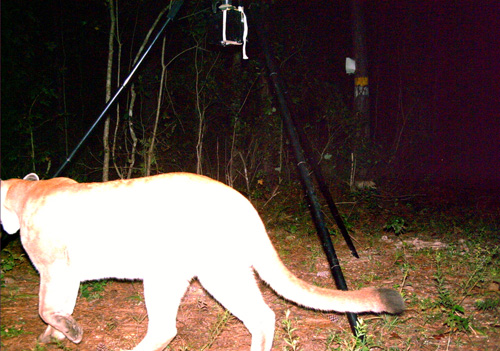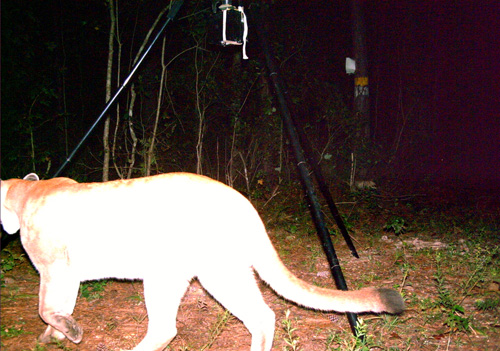Louisiana Confirms Cougars With Photos
Posted by: Loren Coleman on October 13th, 2008
The Louisiana Department of Wildlife and Fisheries verifies two cougar sightings with the release on October 10, 2008, of the photographs below.
The above was taken on September 4, 2008, in Natchitoches Parish, LA.
The above photo was taken on September 29, 2008, in Allen Parish, LA.
[If the two photographs do not immediately upload to your computer, please refresh your browser.]
The entire release is herewith attached:
The Louisiana Department of Wildlife and Fisheries (LDWF) has received photographic evidence of the second and third documented cougar occurrences in the state in recent history.
Private citizens sent trail camera pictures from two different sites to the department in September. LDWF Large Carnivore Program Manager Maria Davidson and LDWF Natural Heritage Zoologist Beau Gregory then conducted site investigations that confirmed the authenticity of the photographs.
“The department interviewed the photo providers and investigated the sites and photographs. After inspecting all of the evidence, we have concluded with the best of our abilities that the photos are in fact real and of a cougar,” Davidson said.
The first photograph was taken in Natchitoches parish on Sept. 4, and the second was taken in Allen parish on Sept. 29. The sites are approximately 100 miles apart, leading to speculation that the same cougar could be in both photos.
“Given the time lapse between the two pictures it is certainly possible for a cougar to have traveled that distance,” Davidson said. “Both animals have the same general appearance of a young cougar, but it is impossible to determine conclusively if the animals are one and the same. It is also impossible to determine if the animals in the photographs are wild free-ranging mountain lions, or escaped captives.”
Although it is illegal to own a cougar in Louisiana, it is possible that there are some illegally held “pets” in the state. Anyone holding a captive cougar in Louisiana must have a permit issued by LDWF, as captive cougars may compromise public safety. LDWF may issue permits to existing owners in the state in order to reduce difficulties associated with determining the validity of reported cougar sightings.
The mountain lion, cougar, panther or puma are names that all refer to the same animal. Their color ranges from lighter tan to brownish grey.
The only species of big cats that occur as black are the jaguar and leopard. Jaguars are native to South America and leopards are native to Africa. Both species can occur as spotted or black, although in both cases the spotted variety is much more common. Although the department receives numerous calls about “black panthers”, there has never been a documented case of a black cougar anywhere in North America.
The first recently documented cougar sighting was in 2002 by LDWF Program Manager Michael Carloss on Lake Fausse Point State Park. That sighting was later confirmed with DNA analysis from scat found at the site.
The department receives many calls reporting sightings of cougars throughout Louisiana. The vast majority of these reports cannot be verified due to the very nature of a sighting. These animals can move through an area and leave little or no evidence to be found. Many of the calls are found to be cases of mistaken identity. Dog tracks make up the majority of the evidence submitted by those reporting cougar sightings. Other animals commonly mistaken for cougars are bobcats and house cats, usually seen from a distance or in varying shades of light.
The significant lack of physical evidence leads the department to conclude that Louisiana does not have an established, breeding population of cougars. In states that have verified small populations of cougars, physical evidence can readily be found in the form of tracks, cached deer kills, scat and road kills. The recent occurrences of cougars in Louisiana may be young animals dispersing from existing populations in west Texas. An expanding population in west Texas can produce dispersing individual cougars that move into suitable habitat in Louisiana. Young males are known to disperse from their birthplace and travel hundreds of miles seeking their own territories.
Cougars that occur in Louisiana are protected under state and federal law. Penalties for taking a cougar in Louisiana may include up to one year in jail and/or a $100,000 fine. Anyone with any information regarding the taking of a cougar should call LA Operation Game Thief, inc. at 1-800-442-2511. Callers may remain anonymous and may receive a cash reward.
To report verifiable sightings of cougars containing physical evidence such as photos, tracks and/or scat please call Maria Davidson at 337-948-0255 or your nearest LDWF Region office at: Minden 318-371-3050 Monroe 318-343-4044 Pineville 318-487-5885 Ferriday 318-757-4571 Lake Charles 337-491-2575 Opelousas 337-948-0255 Baton Rouge 225-765-2360.
For more information, please contact Maria Davidson at 337-948-0255. 2008-291
About Loren Coleman
Loren Coleman is one of the world’s leading cryptozoologists, some say “the” leading living cryptozoologist. Certainly, he is acknowledged as the current living American researcher and writer who has most popularized cryptozoology in the late 20th and early 21st centuries.
Starting his fieldwork and investigations in 1960, after traveling and trekking extensively in pursuit of cryptozoological mysteries, Coleman began writing to share his experiences in 1969. An honorary member of Ivan T. Sanderson’s Society for the Investigation of the Unexplained in the 1970s, Coleman has been bestowed with similar honorary memberships of the North Idaho College Cryptozoology Club in 1983, and in subsequent years, that of the British Columbia Scientific Cryptozoology Club, CryptoSafari International, and other international organizations. He was also a Life Member and Benefactor of the International Society of Cryptozoology (now-defunct).
Loren Coleman’s daily blog, as a member of the Cryptomundo Team, served as an ongoing avenue of communication for the ever-growing body of cryptozoo news from 2005 through 2013. He returned as an infrequent contributor beginning Halloween week of 2015.
Coleman is the founder in 2003, and current director of the International Cryptozoology Museum in Portland, Maine.













Well at least the cameras get Big Cats! Bet they are some in North Georgia, but the DNR says NO!
I was overjoyed when I saw this, since I saw it as proof that my state’s lesser seen denizens were being acknowledge…then I read the accompanying story. Anyone you ask around here will tell you straight that there ARE mountain lions here, and recently there was a sighting of a female with two cubs in tow. Oh well, you can’t win them all…at least acknowledging this is a mountain lion and not some excuse of “misidentified housecat” is a step in the right direction.
Cool beans. Glad it’s proved.
Note that this is a case where official wildlife agencies, presented with proper evidence, promptly confirmed the existence of the cat in their state. It is not always true that “bureaucrats” reject evidence.
We have had the same problem here in Ohio. There have been numerous sightings as well as tracks and other sign collected in the past few months. The Ohio Department of Natural Resources continues to say that they do not exist in Ohio.
I’m always fascinated by why government agencies insist up and down that pumas can’t live east of the Mississippi*, sometimes going so far as to claim that they never did so historically at all! Do they really think people would get freaked out? It seems to me that pumas have been re-colonizing and even expanding their range for decades. Much like leopards, they are a pretty hardy and adaptable cat, and are fairly successful going unnoticed even relatively close to people. I see no reason why they couldn’t easily live in places like Appalachia, New York, the Ozarks, the North Woods around the Great Lakes and the Louisana bayous. Don’t forget, we also have black bears and coyotes in many of these places.
* Florida panther aside, I believe there are accepted pumas up in Ontario and maybe points further east in Canada.
Knowing that pumas are here (in Kentucky), and having indisputable evidence of their existence, are two different things.
I know they are here; I’ve seen one and I know several other reliable, observant people who have also seen them. There has been sporadic evidence too: for instance, the puma kitten that was struck and killed on the highway in Floyd County, and the recent sightings near Mammoth Cave, the Land Between the Lakes, and the Cincinnati/Covington area. It hasn’t been enough to “officially” confirm the pumas’ existence, but I’m confident that that day is approaching.
More and more people are setting up trailcams and other types of camera traps, and it’s only a matter of time. The pumas are there, and sooner or later one will trip a camera.
Ohh I hadn’t heard about the kitten in floyd co. Kittenz. How’d they explain it? I do remember someone over there having a few exotics as pets but I think they had a tiger.
I’ve always heard the stories of ‘panthers’ in ky. Especially from coon hunters who are out all night in the woods.
Here is a link with a photo of the kitten.
This is a quote from a National Wildlife Federation article on eastern pumas:
“Among the more mysterious of these was an 8-pound cougar kitten struck and killed by a motorist in June 1997 in Floyd County, Kentucky. The carcass was turned over to state wildlife department officers, who found various telltale signs that it had been a wild cougar—all claws intact, no tattoos or tags, no collar. Even so, the examiners concluded the animal was probably from domesticated stock.”
The kitten’s DNA indicated a mixture of South American genes (which are usually assumed to be from “pet” pumas) and North American genes – usually thought to indicate a truly wild puma. The kitten had its full set of claws (which had not been clipped), no tattoos nor collar marks, and no indication of anything other than a wild diet in its stomach. The young man whose vehicle struck it said that he glimpsed another small puma, and a big one, with the kitten. Despite that, which suggests to me that pumas are living wild and breeding in eastern Kentucky, state wildlife personnel who examined the kitten’s body concluded that it must have come from “domestic stock”.
There is definitely an attitude of denial among most state wildlife agencies when it comes to pumas. Almost to a person, they refuse to even entertain the possibility that pumas could be repopulating their historic range in the Appalachians. I believe otherwise.